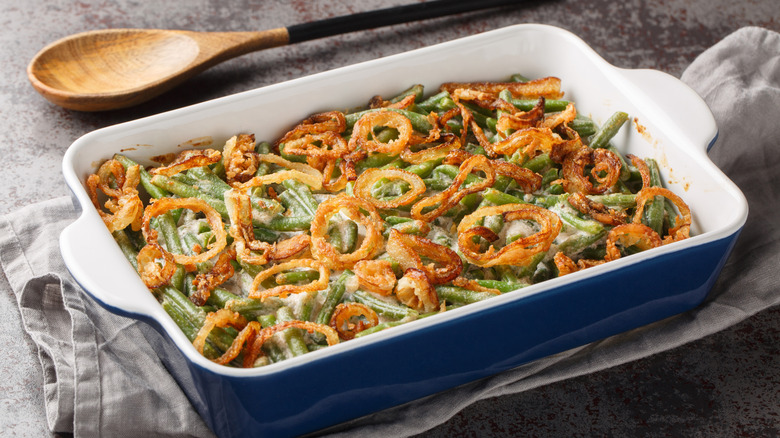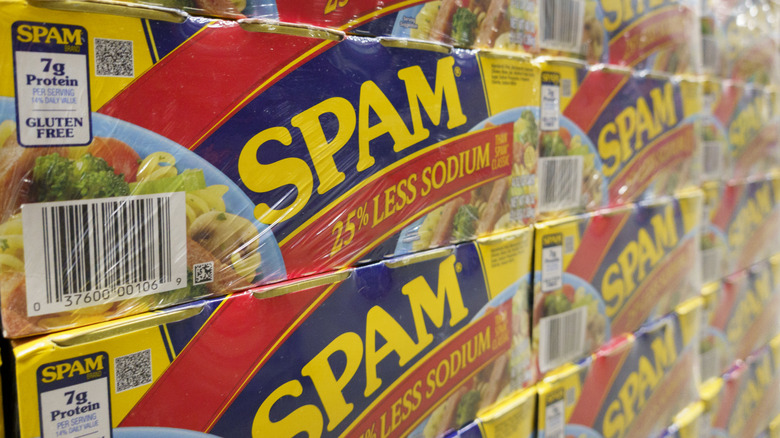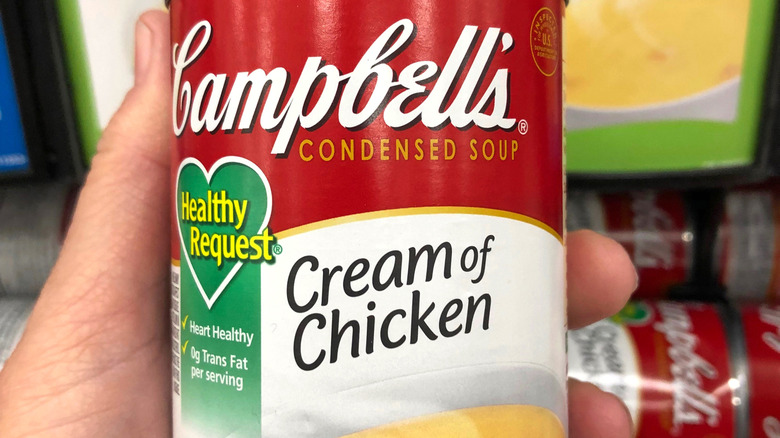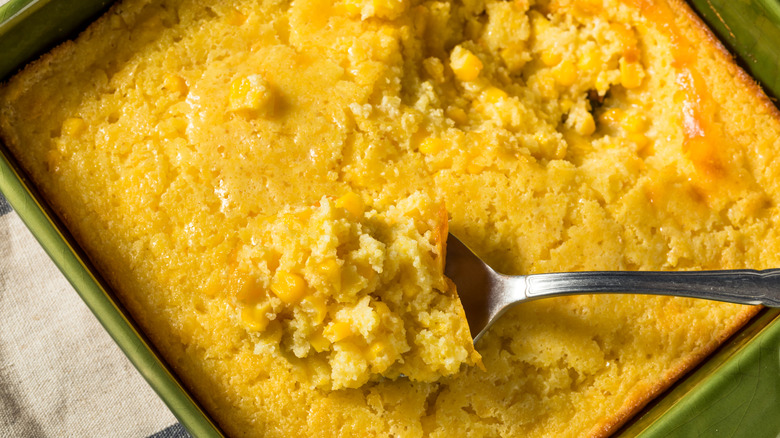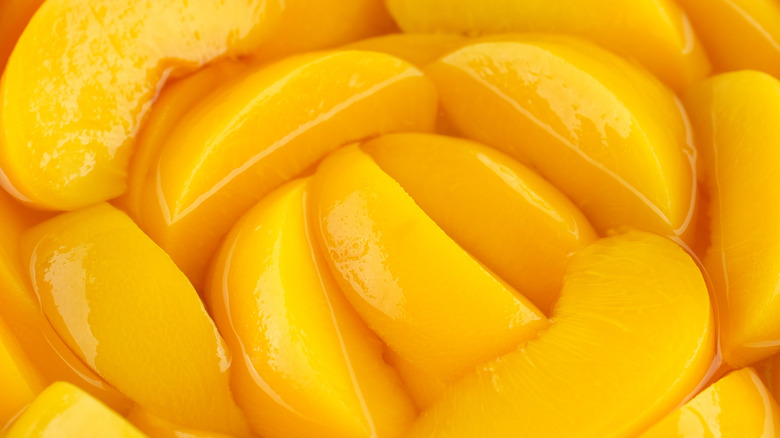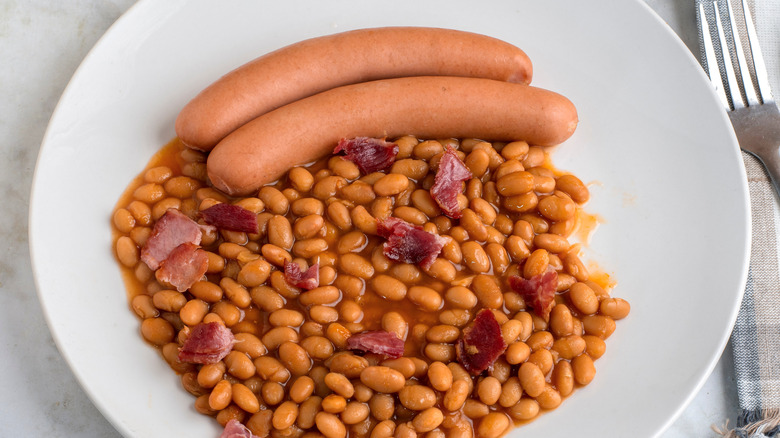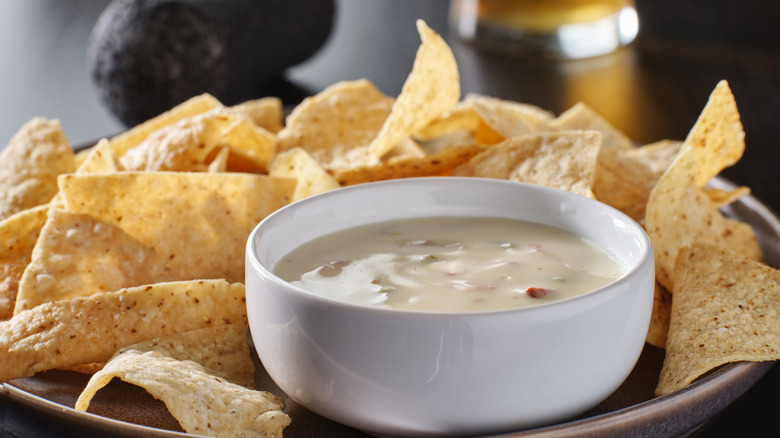Canned Foods That Built Classic American Meals (And Are Still Around)
We may receive a commission on purchases made from links.
Cooking from scratch can be a rewarding process with a huge payoff, but there's no shame in cooking with canned foods. Indeed, they've been a part of American life longer than you may think. The first commercial cannery in the U.S. opened in 1812, and homemakers have long canned their own fruits and vegetables. Some familiar canned foods also have long histories, like condensed milk, which was first introduced in 1856. Other canned items became popular as far back as the Civil War.
Canned and other prepared foods are so deeply embedded into American cooking that some of the most iconic dishes in American cuisine wouldn't have come into being without them. Convenience foods not only speed up our cooking time, but offer consistency: We can count on a casserole featuring a favorite canned sauce to taste the same way every time. This, however, only works as long as our favorite shortcut ingredients are available. For instance, when Pillsbury discontinued its Double Dutch Fudge Buttercream Frosting Mix, bakers howled in protest. It was a key ingredient in the famed Tunnel of Fudge cake, a 1966 Pillsbury Bake-Off runner-up and favorite among home cooks. Pillsbury later reformulated the recipe to work without the mix, but the principle still stung. Luckily, many longtime canned staples are still very much around. Here are some of the most useful of them, along with the iconic dishes they made possible.
Cream of mushroom soup
When Campbell's introduced its cream of mushroom soup in 1934, it made a smart move by marketing it as both a soup and a sauce. As part of that marketing, it charged its home economics department with the task of creating recipes showcasing the soup. The recipes had to be easy for an average cook to make, and use only readily available ingredients. These efforts were wildly successful. By the middle of the 20th century, cream of mushroom soup had become the glue that held many meals together. Classic dishes like tuna noodle casserole and green bean casserole topped with crunchy onions would not exist without it.
These now-iconic dishes weren't just generic corporate projects, however. Both can be traced back to the creative efforts of one person: Dorcas Reilly, supervisor of the home economics department of Campbell's test kitchen. Reilly and her team created the now-classic green bean casserole in 1955 with great deliberation. They aimed for a dish with a short list of ingredients that could be mixed together in the same pan and baked, and the dish succeeded beyond their wildest expectations. Campbell's estimates that up to 40% of its cream of mushroom soup is used to make the casserole. While Reilly was modest about her accomplishments, she received a well-deserved honor: Her handwritten recipe card with the original green bean casserole recipe is now in the archives of the National Inventors Hall of Fame.
Spam
In the decades before it became synonymous with digital junk mail, Spam was an easy-to-cook staple respected for its affordability, versatility, and long shelf life. The beloved (or reviled, depending on whom you ask) ground pork loaf became a staple of Allied troops during World War II, and since Spam went wherever the troops did, it caught the attention of locals in overseas areas where U.S. soldiers were deployed, especially in Japan, Korea, and the Philippines. To these diners, Spam was not only affordable but vaguely exotic, and soon became a favorite ingredient in stews, stir-fries, and other dishes.
In most of the U.S., however, Span is seen as useful in a pinch, but rarely more than that. A conspicuous exception to this trend is in Hawaii, where it remains a favorite pantry staple. Today, residents of Hawaii go through 7 million cans of Spam a year, making Hawaii the state with the highest per-capita Spam consumption. Much of this is enjoyed in the form of Spam musubi, an all-American dish with Japanese roots. A grilled, soy-glazed slice of Spam on top of a layer of sticky rice and wrapped in seaweed. You can think of it like a large-format piece of sushi with Spam standing in for fish. It's such a ubiquitous snack in Hawaii that many households have special musubi molds, the size of a slice of Spam, to ensure their treats come out neatly shaped every time.
Cream of chicken soup
The less-celebrated sister to Campbell's cream of mushroom soup, cream of chicken soup has also become a go-to sauce base for home cooks, adding creaminess and flavor to casseroles and more. While you can just heat it and eat it on its own, it won't make for a very exciting lunch. Rather, its best use is as a shortcut version of velouté sauce. And like velouté, a creamy sauce made from butter, flour, and stock, it serves as a savory but neutral base on which to build more flavorful and distinctive sauces — for instance, you can spice it up to make chicken chili or with a different choice of spices, a creamy curry.
Numerous recipes also combine it with cream of mushroom soup to make a hearty casserole base. For instance, the classic midcentury chicken and rice casserole is little more than cans of both soups mixed with rice and water and baked with chicken. The Tex-Mex favorite, King Ranch casserole, features both soups baked with shredded chicken, corn tortillas, chiles, tomatoes, and cheese.
Creamed corn
Creamed corn has long been a favorite summer dish — but making it from fresh corn is time-consuming and messy. If you've ever cut fresh corn from the cob, you know why: Those kernels tend to land everywhere except your cutting board or mixing bowl. Canned creamed corn isn't quite the same, of course. It's not something you want to heat up and serve at your next cookout if you want your friends to respect you, but as an ingredient in other favorite dishes, it's a convenient and flavorful shortcut.
For instance, a can of creamed corn, along with bacon, potatoes, chicken stock, onions, and milk, can make a fast and satisfying corn chowder. Alternatively, you can make a Chinese-American-style corn soup with a very similar recipe, by skipping the bacon and potatoes, adding shredded chicken, and seasoning the base with ginger, soy sauce, white pepper, and garlic instead. And for an easy-to-make and comforting side perfect for a Thanksgiving potluck, make a classic baked corn pudding with eggs, milk, cornstarch, whole corn kernels, and sugar.
Canned peaches
We won't pretend canned peaches are nearly as tasty as fresh — but they're affordable and convenient to keep around, and make it possible to enjoy colorful, fruity desserts, even in the dead of winter. Like most canned foods, commercially canned peaches, stored at temperatures of 75 F or below, can maintain their quality for around two years, provided the can is undamaged. That makes it easy to keep a few cans around for those times when you're hungry for fruit but don't have anything fresh around.
One reason canned peaches are so comforting to some is that they're at the heart of some of the first dishes young bakers learn to make. For instance, they're the central ingredient in a simple peach cobbler made by pouring a basic batter of flour, baking powder, sugar, and milk over melted butter in a baking pan, then topping the batter with canned peach slices before baking it. The batter rises to partially cover the peaches, letting splashes of bright orange peek through the cakey base once it's cooked. It's nearly foolproof, and a fun little project to make with kids on a rainy day when you're stuck in the house without much in the pantry.
Baked beans
Many of us remember canned baked beans and hot dogs as a casual family meal or an easy dish to throw together on a camping trip. It's such a classic combo that we can even find canned beans with sliced hot dogs already mixed in, like Van Camp's Beanee Weenee. Having been invented in the mid-19th century, canned beans have been around for a long time, becoming an American culinary icon in their own right.
The combo of hot dogs and beans has special resonance for New Englanders, who commonly enjoyed hot dogs and baked beans, either homemade or canned, as their Saturday night dinner. The roots of this tradition go back to the early days of American settlement, to a time when the only baked beans were made from scratch — a process that involves soaking the dried beans overnight, plus hours of baking in a savory-sweet sauce. New England Puritans, who spent their Sundays at church and refrained from cooking on the Sabbath, baked beans for Saturday dinner and kept them warm in the oven to be enjoyed on Sunday. While few modern New Englanders observe Puritan religious practices, the old baked-bean custom remains, and the biggest culinary for many of today's New Englanders is deciding which brand of canned beans to serve.
Ro-Tel tomatoes
Chili-flecked Ro-Tel tomatoes were invented in Texas in 1943 to address a specifically Texan need: To speed up the production of Tex-Mex favorites like queso and chili. The spicy tomatoes were the brainchild of vegetable canner Carl Roettele, who recognized that chopping, cooking, and canning locally grown tomatoes and jalapeños would be a huge timesaver for the area's cooks — and also a good revenue stream for him.
Ro-Tel tomatoes remained a regional favorite until 1963, when Lady Bird Johnson, the soon-to-be First Lady, name-checked them as a secret ingredient in her chili (the other ingredients were meat, chili powder, cumin, garlic, onions, oregano, and a dash of hot sauce). This began Ro-Tel's growth into a national brand, and today, it's a pantry staple in households across the country. For many of us, the gateway recipe for Ro-Tel tomatoes was queso — melted processed cheese with the tomatoes stirred in, but you can also do as Texans do and use it anywhere you want a touch of Tex-Mex flair. Try it in mac and cheese or other creamy casseroles.

